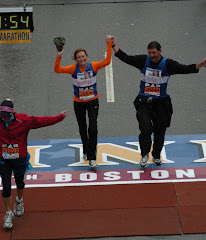As much as I
like to believe that after running 18 Boston marathons that the next one will
be easier, it isn’t. It could be age or
it could just be nerves but for some reason I can’t put into words every
marathon morning carries both excitement to be there and nervousness at what’s
ahead.
For those of
you that have read previous year’s blogs of race day you know that often what
defines the day is the weather. I’ve run in the remnants of a hurricane with winds
so strong they blew over the porta-potties (nasty). There was the year the temperature hit 90
degrees and they considered canceling the race. Spectators brought out garden hoses and ice
to cool down the runners (you’ve got to love Boston spectators). There
was a year when it snowed the day before the race and runners were standing in muddy
slush in the staging area before the start.
While there have been perfect sunny 50 degree days sprinkled in over the
years this was not one of them.
I had the
luxury of staying with the Burnett family the day before and it was perfect…great
food, great company and a warm bed.
When I left for Boston the next morning to catch a 6AM bus to the start
the temperature was in the 30’s with the promise we would warm up to a toasty mid 40’s during the day. Rain would
start late morning and continue throughout the day with winds picking up as we
got close to Boston (in our face of course…we wouldn’t want it to get easier).
Hopkinton is
a small town so they close down the roads into the area by 7AM. Buses pick up runners in Boston for the
hour trip out to the start staging area, attractively called the athlete’s
village. Picture several sports fields
with a large white tent in the center, hundreds of porta-potties lining the
perimeter and 10’s of thousands of runners milling around looking for a way to
stay warm and burn off nervous energy.
Security is high since the bombing 2 years ago including scanning all
runners entering the village and restrictions on what you can have with
you. In prior years you could keep a
bag of clothes with you and as you left the village to head to the start you
could have your extra clothes and personal items placed on a bus that would
meet you in the finish area. With the
changes in security this was no longer possible so what you wear or carry with
you either travels the 26 miles with you or gets discarded at the start. You see some pretty creative outfits as
people wear old clothes and cast offs to stay warm before the race (more on
this later). State Police, National
Guard, canine units and swat teams are all there to help assure the safety of
the runners. They were polite,
supportive and ever vigilant. It felt
good to have them there.
Last year’s
marathon was one of the largest fields as a result of the bombing the year
before. This year’s 30,000 runners were a step up from the normal 26,000 and as a result there was an additional wave
added to the staggered start. The
wheelchair racers go off first (you do not want to be running in front of a
wheelchair racer on a downhill). The
women elite runners go off at 9:30 followed by the elite men and the first wave
of 7500 runners at 10 (and yes, most of us are sitting around since 8AM waiting
for the start). There are 8 corals/wave
and runners are staged in corals based on their qualifying times. Corals are a good name for the process of
packing the runners into the starting areas.
To get to the starting corals you have to walk almost a mile from the
athlete village (because of course you need a warm up before running 26). On
the way, athletes are peeling off all the warm outer clothes they brought and
tossing them to volunteers who are filling thousands of trash bags that will go to
charities. A nice way for runners to
empty their closets and the needy to get some warm clothes.
Wave 2 goes
off at 10:25, Wave 3 at 10:50 and Wave 4 at 11:15. By the time Wave 4 leaves the elite runners
will be past the half way point. I was
in Wave 3 and as I headed down to the start it began raining. One of the tough decisions is deciding what
to wear. With the cold and the rain this
year it was an easier decision…hat, gloves, nylon wind pants long sleeve shirt
and a light rainproof windbreaker. To
stay warm and keep the rain off while waiting for the start I wear a designer
trash bag over my outfit. Very
stylish. One last run to a porta-potty
and I’m ready.
I knew going
into this race that I was not going to run fast enough to requalify. I have been injured off and on over the last
4 months and there was no way to get the kind of performance training in that I
would need. My strategy was to go out
slow and try to avoid aggravating any injuries in the first half of the race
and then take the second half based on how I felt. The rain didn’t change any of this for me; I
just made more wet sloshing sounds as I ran.
There are no
better crowds than the Boston Marathon spectators. Rain didn’t matter…they were out there
cheering like always. You have to love the creativity, like the
guy at around 16 miles with the sign “1 million inches travelled, 660,000 to
go”. Or the people who normally hand out
orange slices or ice, switching to hand out hot coffee and tea. There are a number of places along the route
that play music, live and recorded.
This year one was playing the Boston Red Sox theme song Sweet Caroline
by Neil Diamond. As if to pile on the
pain, it stuck in my head for the next 5 miles. And then there are the Wellesley
girls. You run the gauntlet of a quarter
mile of hundreds of screaming college girls with signs reading “kiss me I’m …”
(you fill in the blank; it gets more creative every year). I swear some of the old guys just run the
race so they can stop there and get a little lip.
My immediate
goal was to make it to 16.5 miles where my family was waiting for me. My twin grandsons at 4 haven’t missed a race
since they were born. Having survived
that far, my sister Terry jumped into the race to run the last 10 miles with
me. She was terrific. It was like having my own concierge. She would get me water, pass me jelly beans and at time run in front
of me to help block the increasing wind.
She even tried at times to hold a conversation with me. I think
I managed to grunt an occasional answer.
From 16 to 21 is a series of up hills that come at a really bad time
(the last of which is the famous Heartbreak Hill). The wind had picked up substantially (20
mph) as we got closer to Boston and was particularly brutal among the
hills. You know it is windy when you go to drink at
the water stops and the water blows back in your face.
From beyond
the hills it was the normal grit your teeth, find somebody tall to run behind
to block the wind and just count off the last 5 miles. It turned out to be one of my slowest
marathons but then again I was just happy to have made it through
uninjured. It will go down as a
memorable one not because of the race itself but because of the people who
supported me along the way. Not only the
ones that were able to brave the cold on race day, but also the ones that sent
words of encouragement and donations to Help in the Nick of Time.
To me those
are my heroes.


